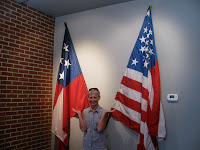
This drive stretches 175 miles from Thomas Jefferson's Monticello in Virginia, through West Virginia, Maryland and ends at Gettysburg, Pennsylvania. Our visit to Monticello was covered in the Blue Ridge Parkway Blog.
From Monticello we decided to detour off the JTHG Corridor and drive through Shenandoah National Park on the Skyline Parkway. The drive was similar to the Blue Ridge Parkway but the mountains were not as intense and their were more views of civilization below particularly the Shenandoah Valley. We camped at Big Meadows in the Shenandoah National Park and had a great hike to Lewis Falls the next morning with a portion along the Appalachian Trail.
After finishing the Skyline Parkway at Front Royal we drove to Manassas National Battlefield Park. The First Battle of Manassas (Bull Run) on July 21, 1861 and the second battle on August 30, 1862 both resulted in victories for the Confederate Forces early in the Civil War. The farmlands of the fields of battle remain much as they were on those two days of bloody fighting. That and the excellent information provided on the walking tour of the first battle's locations brought that initial clash of the two armies of the divided nation with its unexpected loss of young men to life for us.
Our next stop was Harpers Ferry National Historic Park which also saw battles fought during the Civil War and actually changed hands several times during the war.
It is located on the Potomac River where the Shenandoah flows in. This strategic location on the border between West Virginia and Maryland (north) and Virginia (south) led to the transportation and industrial town being nearly destroyed during the war.
But the most important role Harpers Ferry played in the Civil War was its setting for John Brown's Rebellion for freedom of the slaves on October 15 1859 which was one of the triggers of the Civil War.
Our last stop was Gettysburg National Military Park the site of the a three day battle involving more than one hundred thousand soldiers from July 1-3 1863. T here were more casualties (51,000) than any battle fought in North America before or since. The battle ended with the failure of Pickett's Charge by the Confederates and victory for the Union forces. This would be the last incursion by the south into the north and would turn the tide in favour of the north. The war would drag on for two more years. The Visitors Centre has extensive presentations on the battle. We decided to bypass this for a twenty four mile self guided tour of the significant sites of the battle and views of some of the thirteen hundred monuments that decorate this large park surrounding the town of Gettysburg.
Our drive ended at the Soldiers' National Cemetery where many thousands of soldiers from both sides are interred. This cemetery is most famous as the site of the delivery of the Gettysburg Address by President Lincoln four months later at the dedication of the cemetery. This two minute speech changed Gettysburg from a field of death to a symbol of sacrifice and an inspiration to the living.






No comments:
Post a Comment